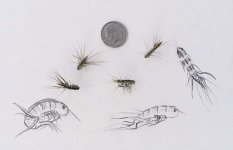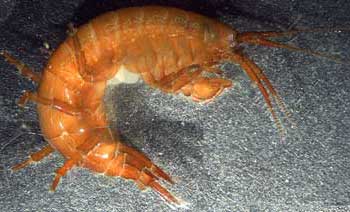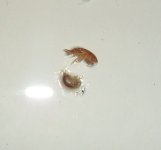F
Fishidiot
Active member
- Joined
- Sep 9, 2006
- Messages
- 9,960
Been playing around with scuds this winter.... Many tiers have traditionally tied their scuds on a curved hook and often with a very dense, packed appearance with a "shell" back and ribbing. There's nothing wrong with these versions - I've used 'em with success for years (as I bet you have too). In recent years, however, I have moved to more slender, elongated patterns to imitate scuds. If you look at scuds in a bowl or tank of water, you will notice that they swim in an elongated fashion. They still have the bent kink near the tail, but it is less obvious than when they are curled up in a ball (as they do when held in your hand, see sketch on left). What is notably obvious when you look at swimming scuds, is the long flowing legs and antennae that stream back with the body and project somewhat on the sides, both above and below the tail, which is itself blended into a point.
Anyway, lacking the photographic skills to capture close up images of these little critters, I tried to sketch 'em instead. The drawings in the middle and on the right reveal these effects: flattened body, streamlined appearance and long, streaming legs that extend further back than the tail when the scud is swimming. When fishing scuds, especially to trout that are visible, I like to give the fly a twitch to imitate the strong swimming abilities of these shrimp.
I think traditional scud patterns, although effective, tend to be too bulky and blunt. I'm also using curved hooks less as I think such flies tend to ride upside down more than those on straight shanks. These days, I try to tie my scuds more sparsely, more elongated, and with much longer hackle for legs in such a way as to get the legs to stream backward.
Scuds are slim, leggy critters when they are swimming.
Anyway, lacking the photographic skills to capture close up images of these little critters, I tried to sketch 'em instead. The drawings in the middle and on the right reveal these effects: flattened body, streamlined appearance and long, streaming legs that extend further back than the tail when the scud is swimming. When fishing scuds, especially to trout that are visible, I like to give the fly a twitch to imitate the strong swimming abilities of these shrimp.
I think traditional scud patterns, although effective, tend to be too bulky and blunt. I'm also using curved hooks less as I think such flies tend to ride upside down more than those on straight shanks. These days, I try to tie my scuds more sparsely, more elongated, and with much longer hackle for legs in such a way as to get the legs to stream backward.
Scuds are slim, leggy critters when they are swimming.







